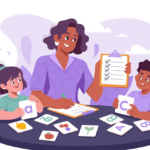
Managing a classroom with students who have ADHD can feel challenging, but it’s also incredibly rewarding. Fortunately, when you have the right tools and ADHD classroom strategies in place, students with ADHD can thrive both academically and socially.
In this post, we’ll explore practical ADHD classroom strategies to improve focus, behavior, and learning outcomes. Whether you’re an experienced teacher or just starting, these tips will help you create an inclusive, supportive environment where every child has the opportunity to succeed.
1. ADHD Classroom Strategies: Establish Clear Routines and Expectations
To begin with, students with ADHD thrive on structure. A predictable routine reduces anxiety and helps maintain focus.
1.1 Use Visual Schedules and Timers
- Start by creating a visual schedule of daily activities that students can easily follow.
- Additionally, use timers to help students transition between tasks seamlessly.
1.2 Reinforce Expectations Regularly
- Make sure to review classroom rules and celebrate small wins along the way.
- Moreover, consistency with routines builds trust and predictability, which helps ADHD students succeed.
2. Incorporate Movement Breaks in ADHD Classroom Strategies
In addition to structure, students with ADHD need regular breaks to release energy and improve focus.
2.1 Brain Breaks to Reset Focus
- First, try tools like GoNoodle for short breathing exercises or quick physical activities.
- Similarly, stretches or walk-and-talk activities can help energize the class.
2.2 Movement-Based ADHD Classroom Strategies
- Let students use wiggle cushions or stand during lessons.
- Furthermore, integrating movement into learning through group rotations or active games makes lessons more engaging.

3. Multi-Sensory ADHD Classroom Strategies to Enhance Learning
Equally important, engaging multiple senses is one of the most effective ADHD classroom strategies to boost focus and retention.
3.1 Visual and Auditory Tools for Engagement
- For instance, use infographics, charts, and videos to explain complex topics.
- Additionally, adding sound effects or calm background music can signal transitions or make group work more focused.
3.2 Hands-On Activities for ADHD Learners
- Consider incorporating hands-on tools like building models or tactile objects to keep students engaged.
- Likewise, interactive whiteboards and apps provide a tech-friendly approach to learning.
4. ADHD Classroom Strategies: Minimize Distractions in the Learning Environment
Of course, students with ADHD are often sensitive to external stimuli. Reducing distractions can go a long way in helping them stay on task.
4.1 Design a Stimulus-Reduced Classroom
- Begin by seating ADHD students in quieter areas, away from windows or busy spots.
- On top of that, keeping wall displays minimal and organized reduces unnecessary distractions.
4.2 Use Tools to Manage Focus
- Another idea is to introduce noise-canceling headphones or “focus stations” for overwhelmed students.
- Additionally, sensory fidget tools can be a great support for self-regulation.

5. Encourage Positive Behavior Using ADHD Classroom Strategies
Finally, positive reinforcement motivates ADHD students and improves classroom behavior.
5.1 Reward Systems for ADHD Students
- Implement systems like points, stickers, or special privileges for positive behavior.
- Above all, celebrate effort and progress rather than focusing only on outcomes.
5.2 Give Clear and Immediate Feedback
- Always use encouraging phrases like:
“Great job staying focused for 15 minutes!” - Importantly, specific praise reinforces desired behaviors effectively.
Looking for More In-Depth ADHD Classroom Strategies?
For a comprehensive guide packed with actionable strategies, templates, and tools to support students with ADHD, check out:
👉 Supporting Students with ADHD: Behavior and Focus

This resource is designed for teachers who want to create a thriving classroom environment while addressing ADHD-related challenges effectively.
Conclusion
In conclusion, supporting students with ADHD doesn’t have to be overwhelming. With these ADHD classroom strategies, you can create a structured, engaging, and inclusive environment where every student can thrive.
So, why wait? Start implementing these tips today, and watch your classroom transform into a space where focus and learning go hand in hand.
Explore More
If you’re looking for additional tips to boost focus in the classroom, check out our related post:
👉 5 Teaching Tips to Boost Classroom Focus and Learning
Subscribe for More Teaching Tips
Want more strategies and teaching insights delivered straight to your inbox?





2 Comments